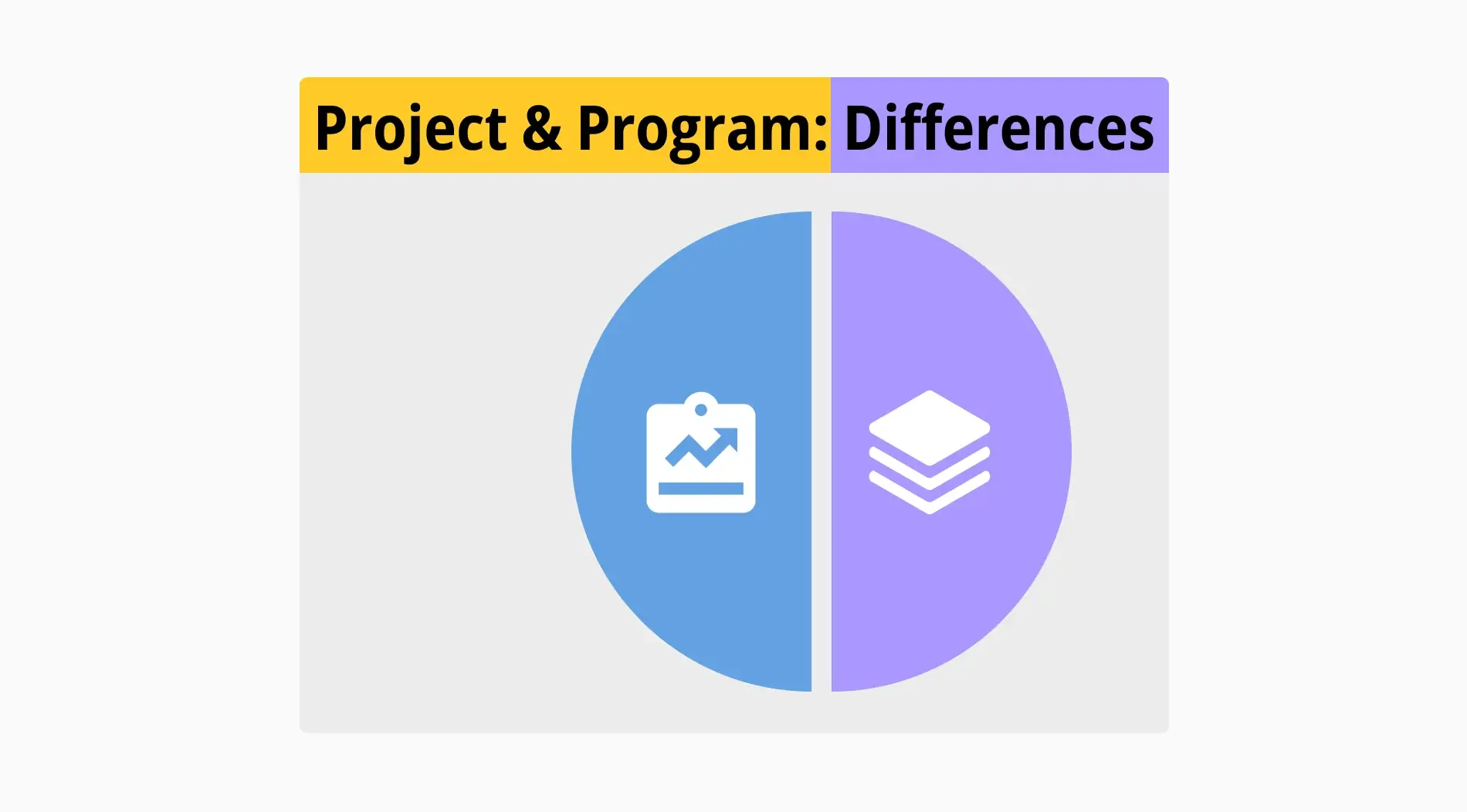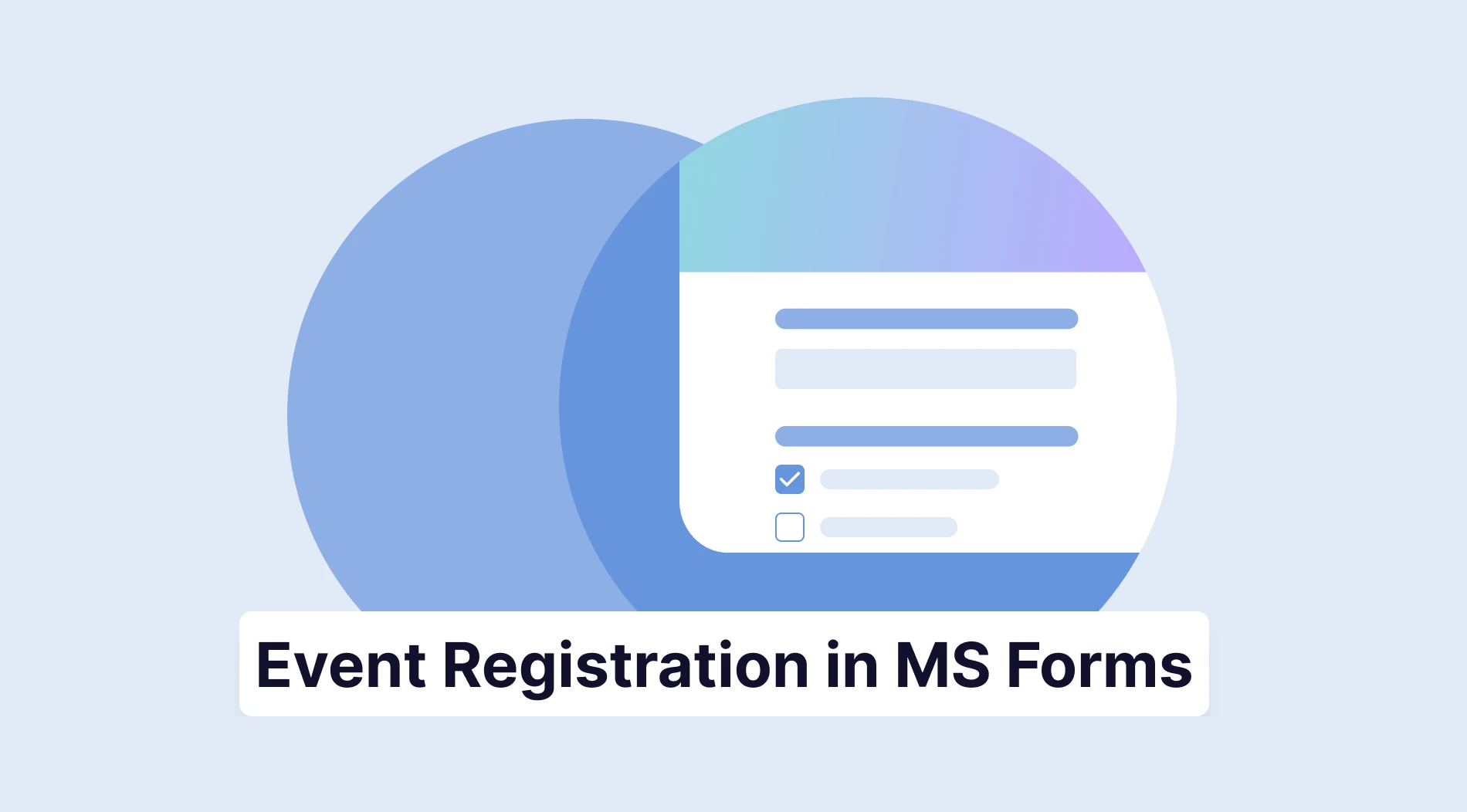Distinguishing between projects and programs is crucial for efficient organizational management. Recognizing their distinct characteristics and purposes enables the application of appropriate strategies, ensuring successful execution and alignment with organizational goals. By understanding these differences, managers can optimize resources and enhance overall project and program performance.
In this article, we will explore the key differences between projects and programs, defining each term, explaining their components, and providing real-life examples. You will also learn how to manage both projects and programs effectively, understand their advantages and disadvantages, and get answers to frequently asked questions.
What is a project?
A project is a temporary endeavor undertaken to create a unique product, service, or result.
It has a specific start and end date, defined objectives, and a scope that outlines the deliverables. Projects are typically constrained by time, budget, and resources and require detailed project planning and management to achieve their goals.
Projects are often initiated to bring about change, solve a problem, or capitalize on an opportunity. They are characterized by a defined timeline, specific deliverables, and a dedicated team working towards the project’s objectives. Once the project goals are met, the project is considered complete and is formally closed.
What is a program?
A program is a group of related projects managed in a coordinated way to achieve strategic objectives and benefits.
Unlike a project, a program is ongoing and does not have a defined end date. Programs are designed to deliver long-term value and are aligned with the organization's broader goals and strategies.
Programs consist of multiple interconnected and interdependent projects. The management of these projects under a single program ensures that resources are optimized, risks are mitigated, and the overall objectives are achieved. Programs provide a framework for managing complex initiatives that require a coordinated approach.
Comparing project and program
By categorizing their key characteristics, such as scope, timeline, and strategic alignment, we can better understand when to utilize each approach effectively. This comparison will shed light on their distinct program and project management roles and advantages in achieving organizational goals.
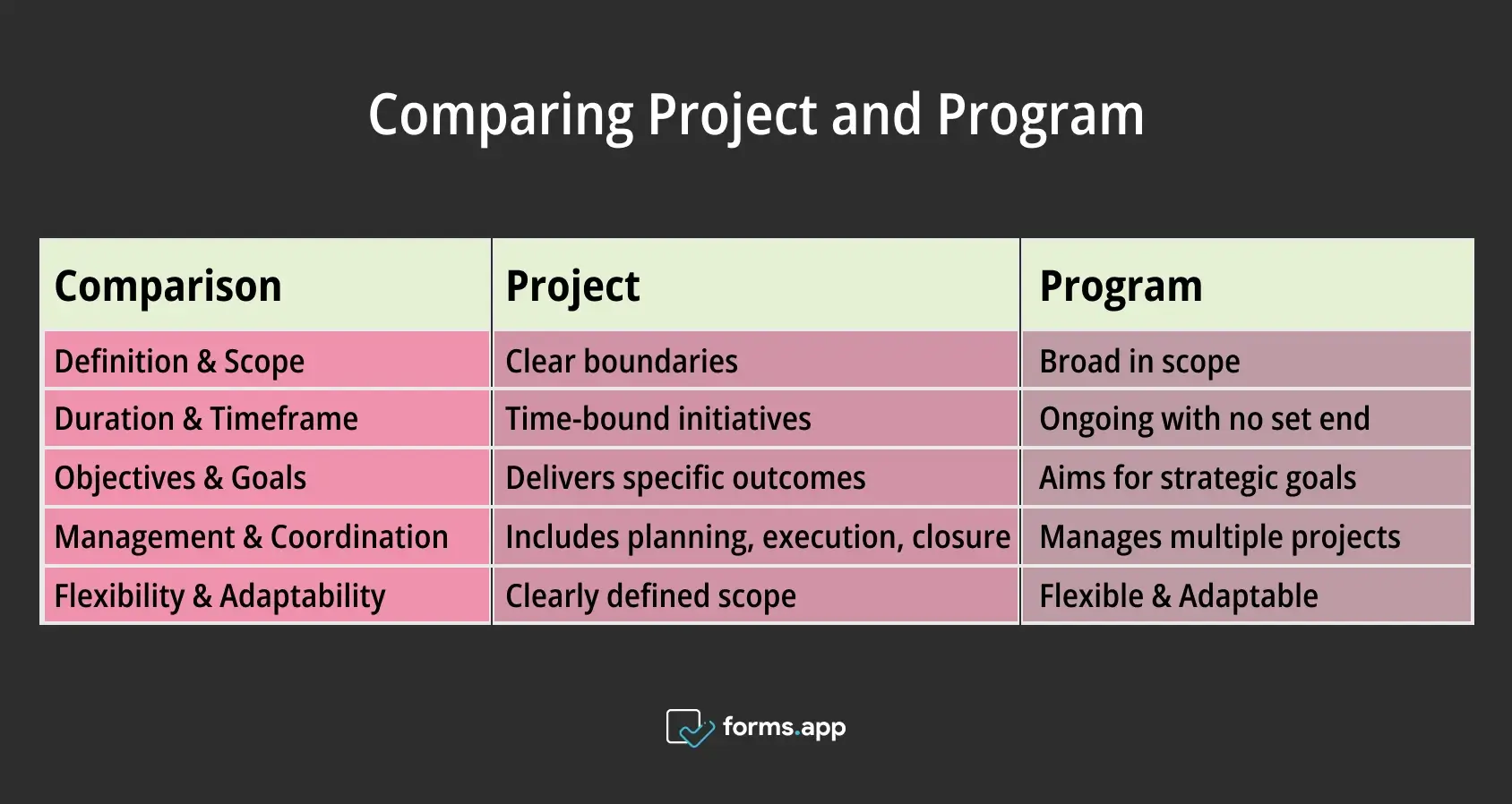
Comparison between project and program
Definition and scope
A project is a finite effort with a specific scope and objectives designed to deliver a unique output. Its scope is well-defined, and any changes to the scope are managed through a change control process. Projects have clear boundaries, and their success is measured by the completion of deliverables within the agreed-upon constraints.
A program, on the other hand, is broader in scope and focuses on achieving strategic objectives through the coordinated management of multiple projects. Its scope is more flexible and can evolve over time to align with changing organizational goals. Programs are designed to deliver long-term benefits and value to the organization.
Duration and timeframe
Projects are temporary initiatives with clear start and end dates aimed at achieving specific objectives within a predetermined timeframe. Their temporary nature emphasizes short-term goals and deliverables, making them focused and goal-oriented. This temporariness allows for concentrated efforts and efficient resource allocation to accomplish defined project tasks within the specified time frame.
Programs are continuous initiatives lacking a set conclusion intended to provide enduring advantages aligned with organizational strategic goals. Unlike projects, they have no predetermined end date and can persist for many years, evolving to suit shifting business demands. This adaptability ensures programs remain relevant and effective, delivering sustained benefits over time.
Objectives and goals
The primary objective of a project is to deliver a unique product, service, or result. Projects have specific goals that are clearly defined at the outset and are measured by the successful completion of deliverables. The focus is on achieving the project’s objectives within the constraints of time, budget, and resources.
Programs, however, are aimed at achieving broader strategic objectives and delivering long-term value. The goals of a program are aligned with the organization’s strategic vision and may encompass multiple projects. The focus is on realizing the overall benefits and achieving the strategic objectives of the organization.
Management and coordination
Project management involves planning, executing, and closing a project to achieve its objectives. It requires detailed planning, resource allocation, risk management, and performance monitoring. Project managers are responsible for ensuring that the project is completed on time, within budget, and to the required quality standards.
Program management, on the other hand, involves the coordinated management of multiple projects to achieve strategic objectives. Program managers oversee the interdependencies between projects, optimize resource allocation, manage risks, and ensure that the program’s objectives are met. They provide strategic oversight to ensure that the individual projects contribute to the overall goals of the program.
Flexibility and adaptability
Projects possess clearly delineated scopes and exhibit limited flexibility regarding alterations. Any modifications to the project scope necessitate formal approval through a change control mechanism. The primary emphasis lies in adhering to pre-established constraints to ensure the project's successful completion within specified parameters.
Programs are more flexible and adaptable to changes. Their scope can evolve over time to align with changing organizational goals and priorities. They are designed to be responsive to changes in the business environment and can adjust their focus to deliver long-term value.
Examples of the difference between a project and a program
Having explored the nuances of project and program management, let's illustrate their differences through examples. By examining real-world scenarios, such as building a single structure versus urban redevelopment initiatives, we can highlight how projects and programs differ in scope, complexity, and strategic impact.
These examples will provide concrete insights into when each approach is most appropriate:
Construction project vs. urban development program
In construction projects, the focus is on building one structure, like an office building, within a set timeframe and budget. The main aim is to finish construction according to specific design plans and quality standards. This requires careful planning and coordination to ensure the project meets all requirements and expectations.
An urban development program, on the other hand, might include multiple construction projects, such as building residential areas, commercial centers, and infrastructure improvements. The program’s objective is to enhance the overall urban environment and improve the quality of life for residents.
Software development project vs. IT transformation program
In a management software development project, the goal is to create a new application or system that meets user needs. The project has clear boundaries in terms of scope, timeline, and budget, with the aim of delivering a fully functional software product. This involves designing, coding, and testing to ensure the final product meets all requirements and functions as intended.
An IT transformation program can involve various projects, such as software development, infrastructure upgrades, and process enhancements. The main aim of such a program is to improve the organization's IT capabilities to align with its strategic goals. This includes modernizing systems, enhancing efficiency, and ensuring technology supports the overall program objectives effectively.
Marketing campaign project vs. brand development program
In a marketing campaign project, the focus is on introducing a new product or service within set time and financial limits. The objective is to accomplish specific marketing goals, like boosting brand visibility or generating sales. This entails strategic planning, creative execution, and effective communication to ensure the campaign resonates with the target audience and achieves the desired outcomes.
A brand development program, however, involves various marketing campaigns, strategies for brand positioning, and initiatives for engaging customers. The primary goal of such a program is to cultivate and reinforce the brand's overall image and reputation. This involves a holistic approach to marketing, focusing on enhancing brand perception, loyalty, and resonance with target audiences across different channels and touchpoints.
Which one to use: Program management vs project management
Now that we've outlined the characteristics of both projects and programs, the question arises: which one should you use? By considering factors such as scope, strategic alignment, and resource management, we can determine whether a project or program approach is most suitable for achieving your organization's goals effectively and efficiently. Let's delve into these considerations to make informed decisions.
Scope and complexity
Choose projects for tasks with well-defined scopes and limited complexity. Projects are suitable when you can clearly outline objectives, deliverables, and timelines. Programs, on the other hand, are preferable for managing interconnected initiatives with greater complexity and uncertainty, requiring a coordinated approach across multiple projects to achieve strategic goals.
Strategic alignment
Select programs when initiatives align with long-term strategic objectives. Programs provide a framework for coordinating multiple projects towards overarching organizational goals, ensuring that efforts are aligned and resources are optimized across initiatives. Projects are ideal for addressing specific, short-term objectives that contribute to broader program objectives but may not require the same strategic alignment.
Resource management
Use programs to optimize resource allocation across multiple related projects. Programs help in managing resources effectively, ensuring that all projects have the necessary support to achieve their objectives while minimizing waste and duplication. Projects typically have more defined resource needs and are executed within predetermined constraints, making resource allocation more straightforward.
Risk management
Opt for programs to provide a coordinated approach to managing risks across interdependent projects. Programs help in identifying and mitigating risks early, ensuring that potential issues do not adversely affect the overall objectives. While projects also involve risk management, programs offer a broader perspective, addressing risks at both the project and program levels to safeguard strategic goals.
Flexibility and adaptability
Choose programs when there is a need for flexibility and adaptability to changing organizational goals and priorities. Programs provide a framework for continuous improvement and adjustment, ensuring that initiatives remain relevant and effective over time. Projects, while focused on specific deliverables, may lack the flexibility to accommodate shifts in strategic direction, making them less suitable for long-term initiatives.
Advantages and disadvantages of projects and programs
Examining the pros and cons of projects and programs provides valuable insights. While projects offer clear scope and focused objectives, programs excel in strategic alignment and resource optimization. However, projects may lack flexibility, and programs can become complex. Understanding these factors helps in choosing the most suitable approach for organizational needs.
Advantages of projects
- Focused objectives: Projects have specific goals and deliverables, making it easier to measure success.
- Defined timeline: The temporary nature of projects allows for clear planning and execution within a set timeframe.
- Resource allocation: Resources are dedicated to achieving specific project goals, ensuring efficiency.
- Flexibility in execution: Projects can adapt to changing requirements through controlled change management processes.
- Measurable outcomes: Success is measured by the completion of deliverables, making it easier to assess performance.
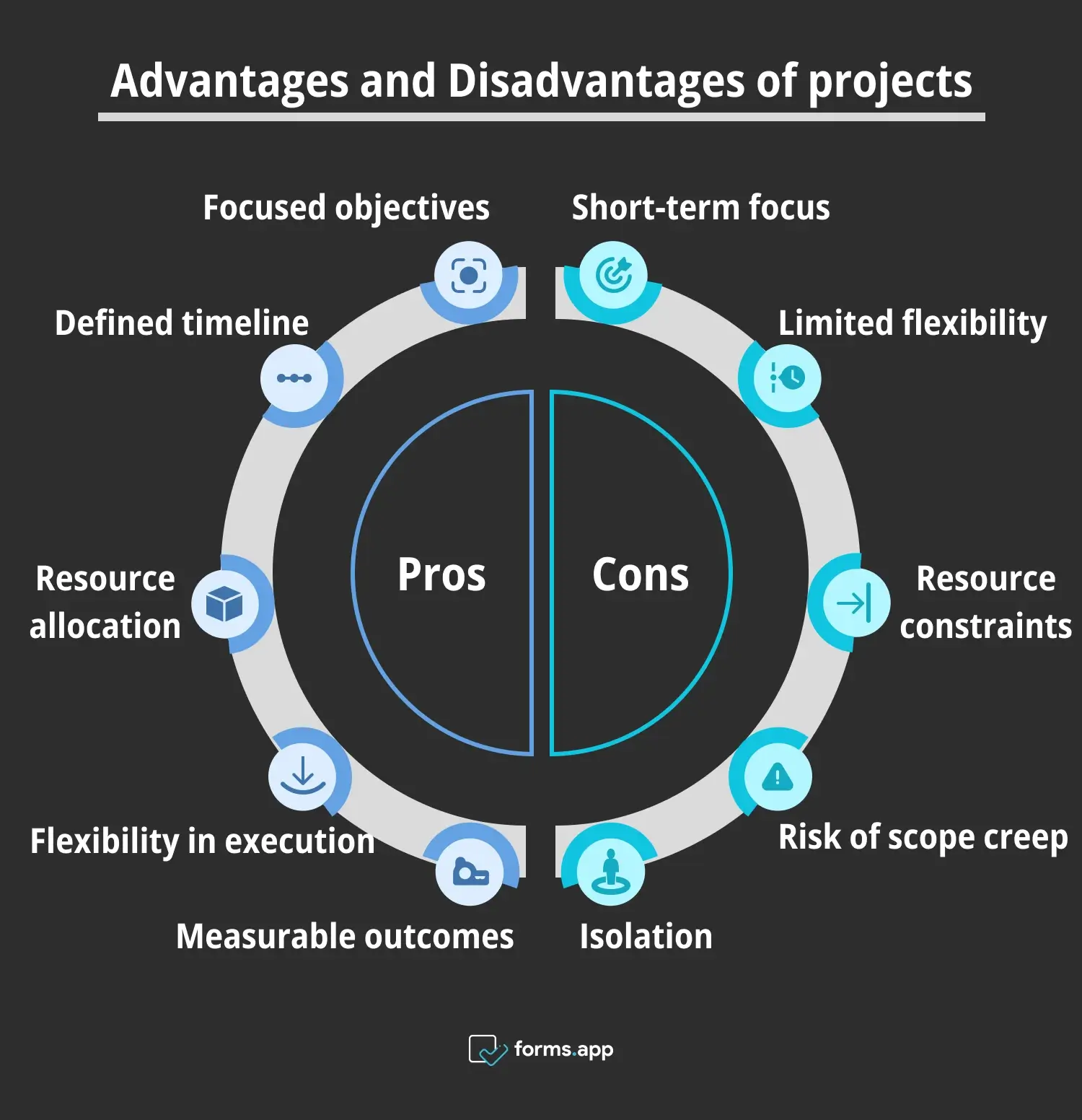
Pros & Cons of projects
Disadvantages of projects
- Short-term focus: Projects focus on short-term goals, which may not align with long-term strategic objectives.
- Limited flexibility: The defined scope and timeline can limit flexibility and adaptability to changes.
- Resource constraints: Projects may face resource constraints that impact their ability to achieve objectives.
- Risk of scope creep: Without careful management, projects can experience scope creep, leading to delays and cost overruns.
- Isolation: Projects may operate in isolation, leading to potential misalignment with broader organizational goals.
Advantages of programs
- Strategic alignment: Programs align multiple projects with the organization’s strategic objectives, ensuring long-term value.
- Resource optimization: Programs optimize resource allocation across multiple projects, enhancing efficiency.
- Risk management: Programs provide a coordinated approach to managing risks across interdependent projects.
- Enhanced coordination: Programs ensure effective communication and collaboration among multiple project team members.
- Long-term benefits: Programs deliver sustained benefits and value aligned with the organization’s strategic goals.
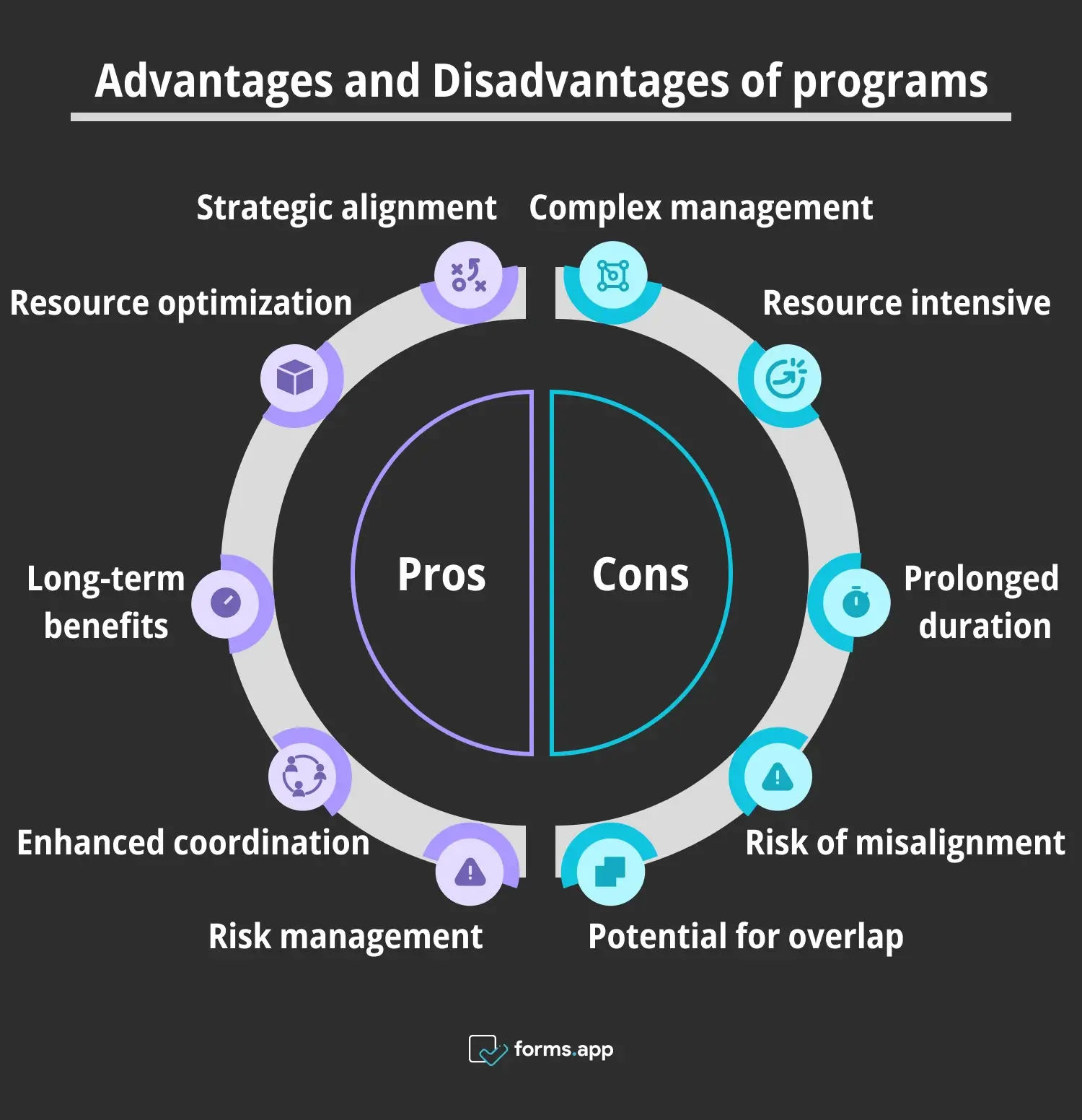
Pros & Cons of programs
Disadvantages of programs
- Complex management: Programs require complex coordination and management of multiple projects.
- Resource intensive: Programs can be resource-intensive, requiring significant investment in planning and execution.
- Prolonged duration: The ongoing nature of programs can make it challenging to maintain focus and momentum.
- Risk of misalignment: Programs may face challenges in ensuring all projects remain aligned with the strategic objectives.
- Potential for overlap: Managing interdependencies between projects can lead to potential overlaps and conflicts.
Frequently asked questions about the project and program
Let's uncover the answers to frequently asked questions about projects and programs. By addressing inquiries regarding their differences, applications, and benefits, we can better understand how each approach contributes to organizational success. Join us as we navigate the complexities of project and program management to unlock valuable insights.
A project is a temporary endeavor to achieve specific objectives, while a program comprises multiple related projects managed together to achieve strategic goals. In contrast, a process is a series of interrelated activities aimed at consistently delivering a desired outcome over time, often repetitively.
While both involve sequential activities, a project with phases focuses on completing specific deliverables within each phase. It tracks progress towards project completion. In contrast, a program coordinates multiple projects with its own phases to achieve broader strategic objectives aligned with the organization's goals.
A project management office (PMO) oversees individual projects, ensuring they meet objectives and adhere to standards. It provides support, guidance, and resources to project managers. Conversely, a program management office (PgMO) focuses on coordinating multiple projects within a program, aligning efforts with strategic goals, and resolving interdependencies between projects.
An example of a project could be building a new office facility, focusing on specific deliverables like construction, interior design, and technology setup. In contrast, a program example could involve urban redevelopment, encompassing multiple projects such as infrastructure upgrades, housing initiatives, and community revitalization efforts, all aligned to achieve strategic urban development goals.
Project design focuses on defining specific deliverables, activities, and timelines to achieve project objectives within defined constraints. In contrast, program design considers the interdependencies between multiple projects, resource allocation, stakeholder engagement, risk management, and overall strategic alignment to successfully deliver the program's objectives.
An example of a program could be implementing a new technology platform across an organization, involving various projects such as software development, data migration, training, and change management. These projects are coordinated under the program umbrella to ensure seamless integration, alignment with business objectives, and maximize benefits realization.
Key points to take away
Understanding the difference between projects and programs is crucial for effective management and achieving organizational goals. Projects focus on specific deliverables within a defined timeframe, while programs coordinate multiple projects to deliver long-term strategic value.
In this article, we explored the key differences between projects and programs, their components, management approaches, and practical applications. Apply this knowledge to enhance your organization’s ability to manage both projects and programs effectively, ensuring successful outcomes and strategic alignment.
Fatih is a content writer at forms.app and a translator specializing in many text domains, including medical, legal, and technical. He loves studying foreign languages. Fatih especially likes to create content about program management, organizational models, and planning tools.
- What is a project?
- What is a program?
- Comparing project and program
- Examples of the difference between a project and a program
- Which one to use: Program management vs project management
- Advantages and disadvantages of projects and programs
- Frequently asked questions about the project and program
- Key points to take away
